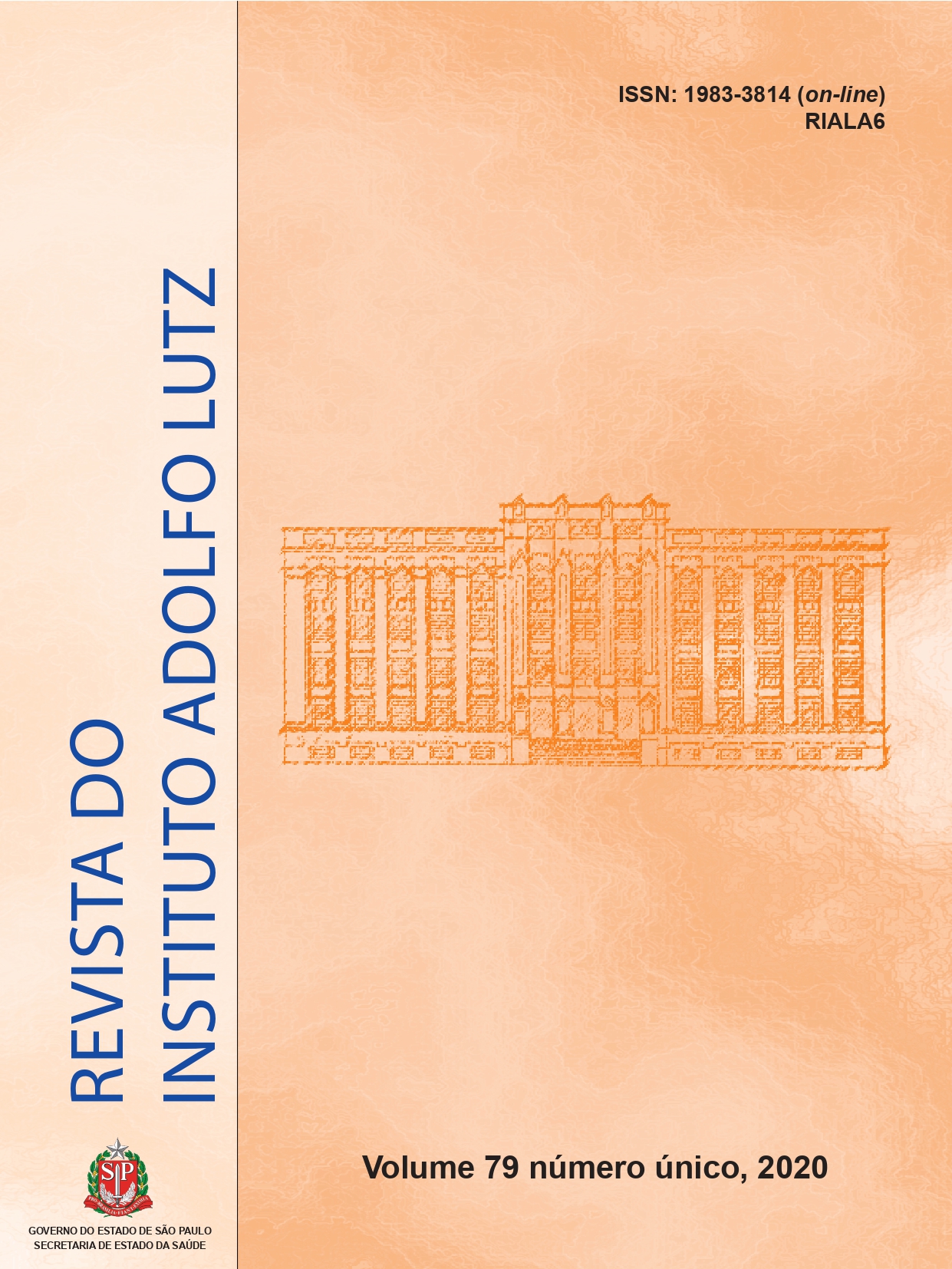Abstract
Mycotoxins are toxic compounds produced by fungi found in food. The most toxic mycotoxins are
the aflatoxins produced mainly by Aspergillus flavus. Studies carried out in Brazil showed a high
incidence of these mycotoxins in peanut products, a fact that represents public health problems.
The aim of the study was to evaluate aflatoxins B1, B2, G1, and G2 in samples of peanuts sold in cities
of the Northeast of the State of São Paulo in the period from 1994 to 2001 and from 2016 to 2017.
The samples of the first period were analyzed using liquid-liquid extraction and thin-layer
chromatography and the second using immunoaffinity columns, post-column derivative liquid
chromatography and fluorescence detector. In the 1994-2001 survey, among 82 samples, 39%
presented aflatoxins contamination ranging from 11 to 1556 μg/kg with 37% with levels greater
than 20 μg/kg whereas, in the 2016-17 survey, 38% of the 56 samples presented contamination of
aflatoxins ranging from 0.09 to 60.40 μg/kg and 7 samples 13% containing aflatoxins levels higher
than 20 μg/kg. The results indicated there was a decrease in the incidence and level of aflatoxins, but
the contamination of aflatoxins in peanuts remains a public health problem.
References
1. Council for Agricultural Science and Technology (CAST). Mycotoxins: Risks in Plant, Animal, and Human Systems. Ames (IA): CAST; 2003.
2. International Agency for Research on Cancer (IARC). Evaluation of carcinogenic risks of chemicals to humans. Some naturally occurring substances. Food items and constituents. Heterocyclic aromatic amines and mycotoxins. Monographs, vol. 56. Lyon (France): IARC; 1993.
3. Cui A, Hua H, Shao T, Song P, Kong Q, Luo T et al. Aflatoxin B1 induces Src phosphorylation and stimulates lung cancer cell migration. Tumour Biol. 2015;36(8):6507-13. https://dx.doi. org/10.1007/s13277-015-3341-2
4. Hernandez-Vargas H, Castelino J, Silver MJ, Dominguez-Salas P, Cros MP, Durand G et al. Exposure to aflatoxin B1 in utero is associated with DNA methylation in white blood cells of infants in The Gambia. Int J Epidemiol. 2015;4(4):1238-48. https://doi.org/10.1093/ije/dyv027
5. Kew MK. Aflatoxins as a Cause of Hepatocellular Carcinoma. J Gastrointestin Liver Dis. 2013;22(3):305-10.
6. Liu Y, Chang CCH, Marsh GM, Wu F. Population attributable risk of aflatoxin-related liver cancer: systematic review and meta-analysis. Eur J Cancer. 2012;48(14):2125-36. https://doi.org/10.1016/j.ejca.2012.02.009
7. Kamika I, Takoy LL. Natural occurrence of Aflatoxin B1 in peanut collected from Kinshasa, Democratic Republic of Congo. Food Control. 2011;22(11):1760-4. https://doi.org/10.1016/j.foodcont.2011.04.010
8. Mutegi CK, Ngugi HK, Hendriks SL, Jones RB. Prevalence and factors associated with aflatoxin contamination of peanuts from Western Kenya. Int J Food Microbiol. 2009;130(1):27-34. https://doi.drg/10.1016/j.ijfoodmicro.2008.12.030
9. Kouadio JH, Lattanzio VM, Ouattara D, Kouakou B, Visconti A. Assessment of mycotoxin exposure in Côte d’ivoire (Ivory Coast) through multibiomarker analysis and possible correlation with food consumption patterns. Toxicol Int. 2014;21(3):248-57. https://doi.org/10.4103/0971-6580.155336
10. Santos AC, Souza AA, Silva MV, Nerilo SB, Souza APM, Bando E et al. Occurrence and exposure assessment to aflatoxins in peanuts commercialized in the northwest of Parana, Brazil. Ciênc Rural. 2018 48(6):e20170615. http://dx.doi.org/10.1590/0103-8478cr20170615
11. Martins LM, Sant’Ana AS, Fungaro MHP, Silva JJ, Nascimento MS, Frisvad JC et al. The biodiversity of Aspergillus section Flavi and aflatoxins in the Brazilian peanut production chain. Food Res Int. 2017;94:101-7. https://doi.org/10.1016/j.foodres.2017.02.006
12. Moreira MF, Oliveira TR, Vieira IGP, Freire FCO, Silva SC, Ribeiro LM et al. Occurrence of fungi and aflatoxins B in nuts and products marketed the Brazilian northeastern regions. Rev Inst Adolfo Lutz. 2016;75:e1698. Disponível em: http://www.ial.sp.gov.br/resources/insituto-adolfo-lutz/publicacoes/
rial/10/rial75_completa/artigos-separados/1698.pdf
13. Silva RA, Yakamoto IT, Ferreira LO, Marques LRM. Detecção e quantificação de aflatoxinas em amostras de grãos de amendoim e derivados comercializados na região de Marília- SP, 2002-2009. Braz J Food Nutr 2013;24(1):61-4. Disponível em: http://servbib.fcfar.unesp.br/seer/index.php/alimentos/article/view/2030/2030
14. Soares LM, Rodriguez-Amaya DB. Survey of aflatoxins, ochratoxin A, zearalenone, and sterigmatocystin in some Brazilian foods by using multi-toxin thin-layer chromatographic method. J Assoc Off Anal Chem. 1989;72(1):22-6.
15. Iha MH, Okada IA, Briganti RC, Mini CA, Trucksess MW. Aflatoxins in Brazilian peanut confection. J AOAC Int. 2016;99(3):830-4. https://doi.org/10.5740/jaoacint.15-0256
16. Berthiller F, Cramer B, Iha MH, Krska R, Lattanzio VMT, MacDonald S et al. Developments in mycotoxin analysis: an update for 2016-2017. World Mycotoxin J. 2018;11(1):5-32. https://doi.org/10.3920/WMJ2017.2250
17. AOAC International. Official Methods of Analysis of AOAC INTERNATIONAL. 18th ed., Gaithersburg (MD); 2010, Chapter 49, p. 1–51.
18. Ministério da Saúde (BR). Comissão Nacional de Normas e Padrões para Alimentos. Resolução - CNNPA nº 34, de 1976. Fixar para os alimentos, tolerâncias de 30ppb (trinta partes por bilhão) para as Aflatoxinas, calculada pela soma dos conteúdos das aflatoxinas B1 e G1. Diário Oficial da União. Brasília, DF, 19 jan 1977. Seção 1.
19. Ministério da Saúde (BR). Agência Nacional de Vigilância Sanitária. Resolução RDC n° 7, de 18 de fevereiro de 2011. Dispõe sobre limites máximos tolerados (LMT) para micotoxinas em alimentos. Diário Oficial da União. Brasília, DF, Seção 1(46):66.
20. Ministério da Saúde (BR). Agência Nacional de Vigilância Sanitária. Resolução RDC n° 7, 274, de 15 de outubro de 2002. Aprova o Regulamento Técnico Sobre Limites Máximos de Aflatoxinas Admissíveis no Leite, no Amendoim, no Milho, constante do Anexo desta Resolução. Diário Oficial da União. Brasília, DF, [acesso 2019 Ago 27]. Disponível em: http://bvsms.saude.gov.br/bvs/saudelegis/anvisa/2002/res0274_15_10_2002.html
21. Associação Brasileira da Indústria de Chocolates, Amendoim e Balas. A ABICAB e o Programa Pró-Amendoim. [acesso 2019 Ago 27]. Disponível em:
22. Facca MCL, Dalzoto PR. Aflatoxinas: um perfil da situação do amendoim e derivados no cenário brasileiro.Biológico. 2010;72(1):25-9.
23. Kaushik G. Effect of processing on mycotoxin content in grains., Crit Rev Food Sci Nutr. 2015;55(12):1672-83.

This work is licensed under a Creative Commons Attribution 4.0 International License.
Copyright (c) 2020 Revista do Instituto Adolfo Lutz
